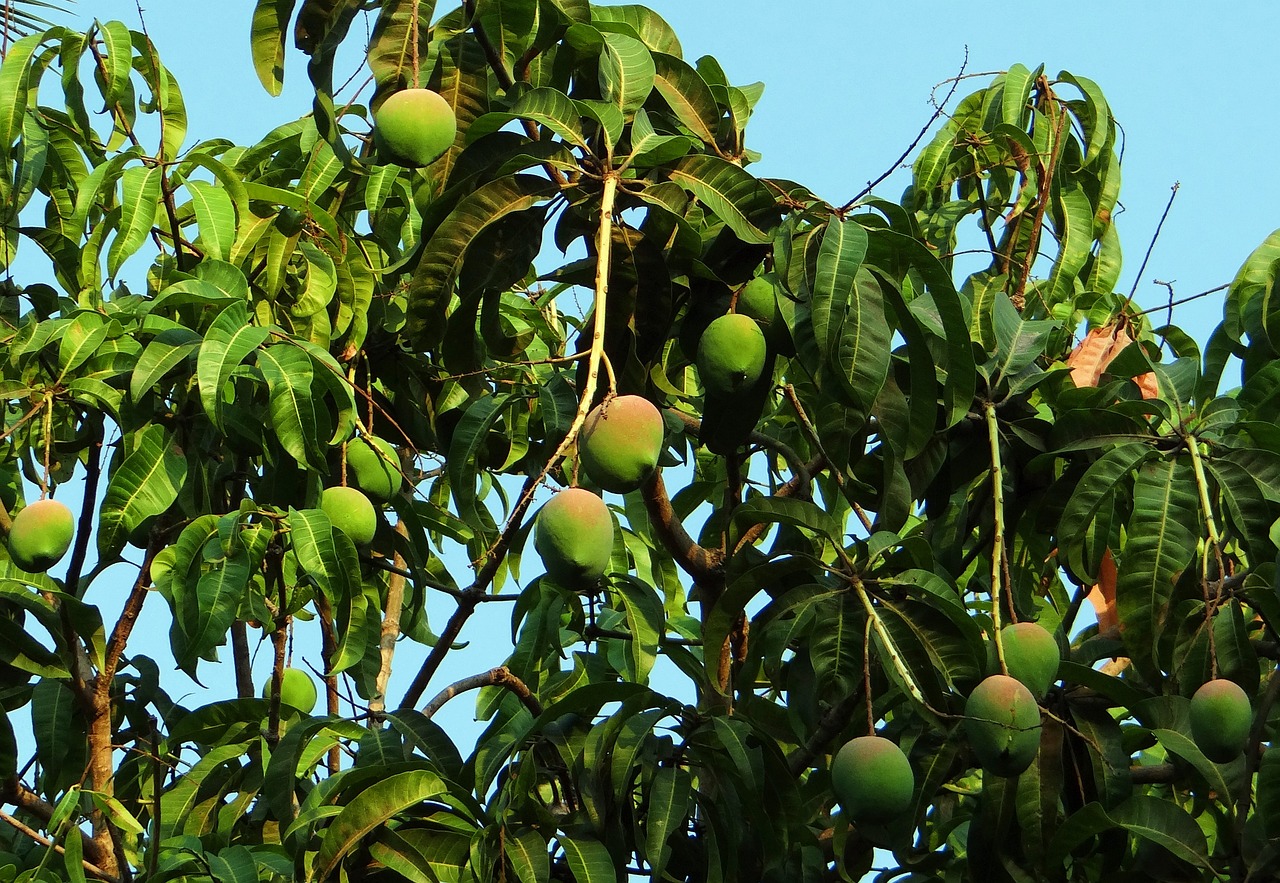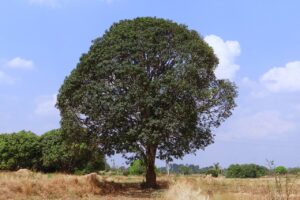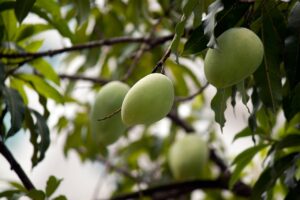Mango
Overview
The revered mango plant, *Mangifera indica L.*, is a diverse, tropical perennial with over 500 varieties. Thriving best in spacious tropical climates, these lush trees offer not only delectable, nutritious fruits but also enhance gardens with their stately presence. With dwarf versions for tight spaces and rich cultural significance, mango cultivation requires know-how on planting, maintenance, and disease management1 2 4 5.

Characteristics
Known for its lush foliage, elongated flowering panicles, and sweet, juicy fruits, with cultivars capable of reaching towering heights in tropical climates.
Region
Typically found in tropical and subtropical regions worldwide.
Natural Habitat
Mango plants are typically found in tropical forests.
Cultivation
Requires full sun, moderate watering once established, and well-drained, fertile soil with a pH between 5.5 and 7.5.
Uses and Benefits
Mangoes, the “king of fruits,” offer more than just a delightful sweetness3. These tropical treats are not only fat-free but also contain no cholesterol or sodium, making them a fantastic choice for various nutritional needs2.
In addition to their irresistible taste, mangoes pack a powerful punch of vitamins and minerals that support overall health and well-being. Introducing this vibrant fruit into your diet can:
- Add a refreshing twist to your meals
- Boost your nutrient intake
- Provide a delicious way to support your wellness goals
The versatility of mangoes makes them a breeze to incorporate into your culinary creations. Try:
- Savoring a perfectly ripe mango slice
- Blending them into a creamy, refreshing smoothie
- Adding them to salads for a burst of sweetness
- Grilling them for a unique, caramelized flavor
No matter how you choose to enjoy them, mangoes offer a delightful and nutritious addition to your diet. Embrace the many benefits of this incredible fruit and let your creativity shine in the kitchen!

Cultivation Tips
Cultivating a mango tree can be a rewarding endeavor. To ensure your mango thrives, consider the following tips:
- Provide ample space for your mango to flourish. If you have limited space, opt for dwarf or condo varieties that are better suited to smaller gardens or containers1.
- Choose a sunny position with well-draining soil. Mango trees are tropical natives that require plenty of sunlight to produce their sweet, luscious fruits2.
- Prune your mango tree regularly. This will help maintain a manageable size and encourage better fruit yields4. Remove any dead, damaged, or crossing branches to promote healthy growth.
- Fertilize your mango tree according to its specific nutrient needs. Consult local gardening resources or experts to understand the best fertilization practices for mango trees in your region2.
By following these cultivation tips, you can successfully grow your own mango tree and enjoy the delightful taste of homegrown mangoes straight from your garden!
Seasonal Considerations
When it comes to seasonal considerations for growing mangoes, timing is key. In regions with cold winters, it’s best to plant young mango trees in spring, after the risk of frost has passed. This gives them time to establish before cooler temperatures arrive. For those in milder climates, planting can be done nearly any time of year, although avoiding extreme heat spells is advisable.
Mangoes have specific water needs that vary by season. During the flowering and fruit-developing stages, usually spring and summer, regular deep watering is crucial. As the weather cools and growth slows, reduce watering frequency. Be mindful of your climate’s rain patterns and adjust irrigation accordingly to avoid oversaturating the soil.
Fertilizing should also be tailored to the seasonal growth cycle. Apply balanced, slow-release fertilizers at the start of the growing season to support healthy leaf and branch development. As flowering begins, switch to a formula higher in potassium to encourage better blooms and fruit set. Always avoid fertilizing during dormant winter months.
While mangoes are evergreen, they still benefit from occasional pruning. The best time for this is typically after the fruiting season ends, giving the tree ample time to recover before the next flowering phase. Focus on removing dead, damaged, or crossing branches to maintain an open, healthy structure.
By understanding the seasonal needs of mangoes and providing appropriate care at the right times, you’ll be well on your way to cultivating a thriving tree and enjoying bountiful harvests of delicious, homegrown fruit1.

Issues and Troubleshooting
Mango trees, while majestic and yielding luscious fruits, can face several cultivation challenges. Growers might contend with mango malformation, a developmental anomaly, and biennial bearing, where production alternates between high and low years.
Pest and disease issues can also hinder growth and fruit quality, such as:
- Clustering (Jhumka)
- Black tip
- Soft nose
- Spongy tissue
- Mango hoppers
- Powdery mildew5
To ensure a bountiful harvest, addressing these problems often requires a mix of:
- Proper cultural practices: Maintain optimal growing conditions through appropriate watering, fertilizing, and pruning techniques.
- Vigilant monitoring: Regularly inspect trees for signs of pests, diseases, or abnormalities to catch issues early.
- Appropriate treatments: When necessary, apply targeted treatments such as pruning affected areas, using organic or chemical pest control methods, and managing environmental factors.
By staying proactive and employing a combination of these strategies, mango growers can effectively troubleshoot common issues and enjoy a thriving, fruitful harvest.
History and Folklore
Mangoes (Mangifera indica L.) have captivated hearts and taste buds throughout history. Hailing from southern Asia and eastern India, these beloved fruits have earned the title “king of fruits” for their irresistible flavors and cultural significance3.
The mango’s journey from wild fruit to cherished backyard staple is filled with tales that span continents and cultures. In India, mangoes are not merely a fruit but a symbol of life itself, playing a crucial role in rituals and celebrations. Folklore even suggests that Buddha found serenity in a peaceful mango grove.
This rich history highlights the mango’s status as more than just a delicious treat. It is a treasured piece of cultural heritage that continues to thrive in modern orchards worldwide3. From ancient origins to present-day popularity, the mango’s enduring appeal is a testament to its timeless allure.
References
1. How to Grow a Mango Tree: Planting, Caring and Harvesting, https://www.plantfoodathome.com/how-to-grow-a-mango-tree/
2. Mango Cultivation Guide: From Soil To Harvesting, https://agriculturereview.com/mangoes-cultivation-guide
3. Mango Farming, Cultivation, Types & Benefits: A Comprehensive Guide, https://easytoplant.com/mango-farming-cultivation-types-benefits-a-comprehensive-guide/
4. How to Plant and Grow Mango – Harvest to Table, https://harvesttotable.com/how-to-grow-mango/
5. Complete guide to mango cultivation – AgroTexGlobal, https://agrotexglobal.com/complete-guide-to-mango-cultivation/
Image Credit: sarangib
Image Credit: sarangib
Image Credit: PublicDomainPictures
Nicolas Duval
Nicolas is a passionate advocate for nature and the art of wildcrafting. His dedication shines through in Wildcraftia, a website he meticulously crafted to serve as a haven for nature enthusiasts worldwide. Driven by a deep appreciation for nature’s connection to humanity, Nicolas embarked on his journey in 2011 with SmokableHerbs, a platform showcasing his love for nature’s bounty. Building upon this foundation, he established Smokably, a thriving online store offering premium herbs and blends to a global audience.
